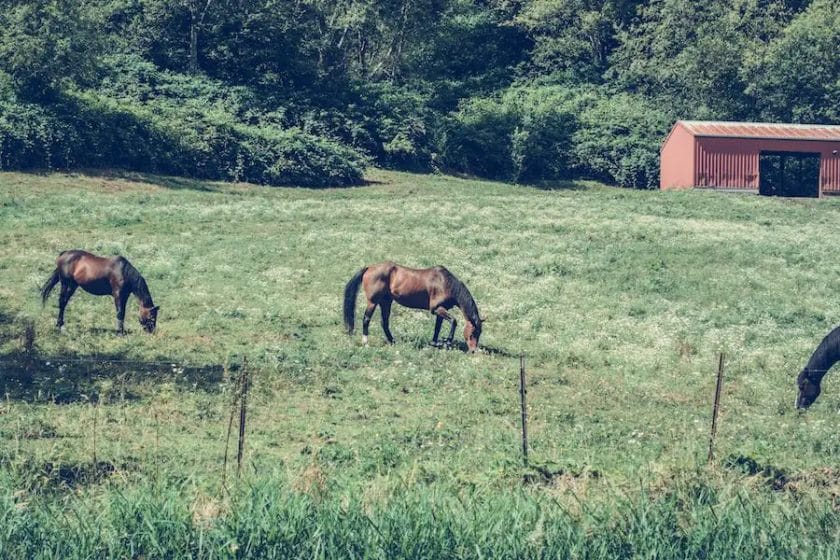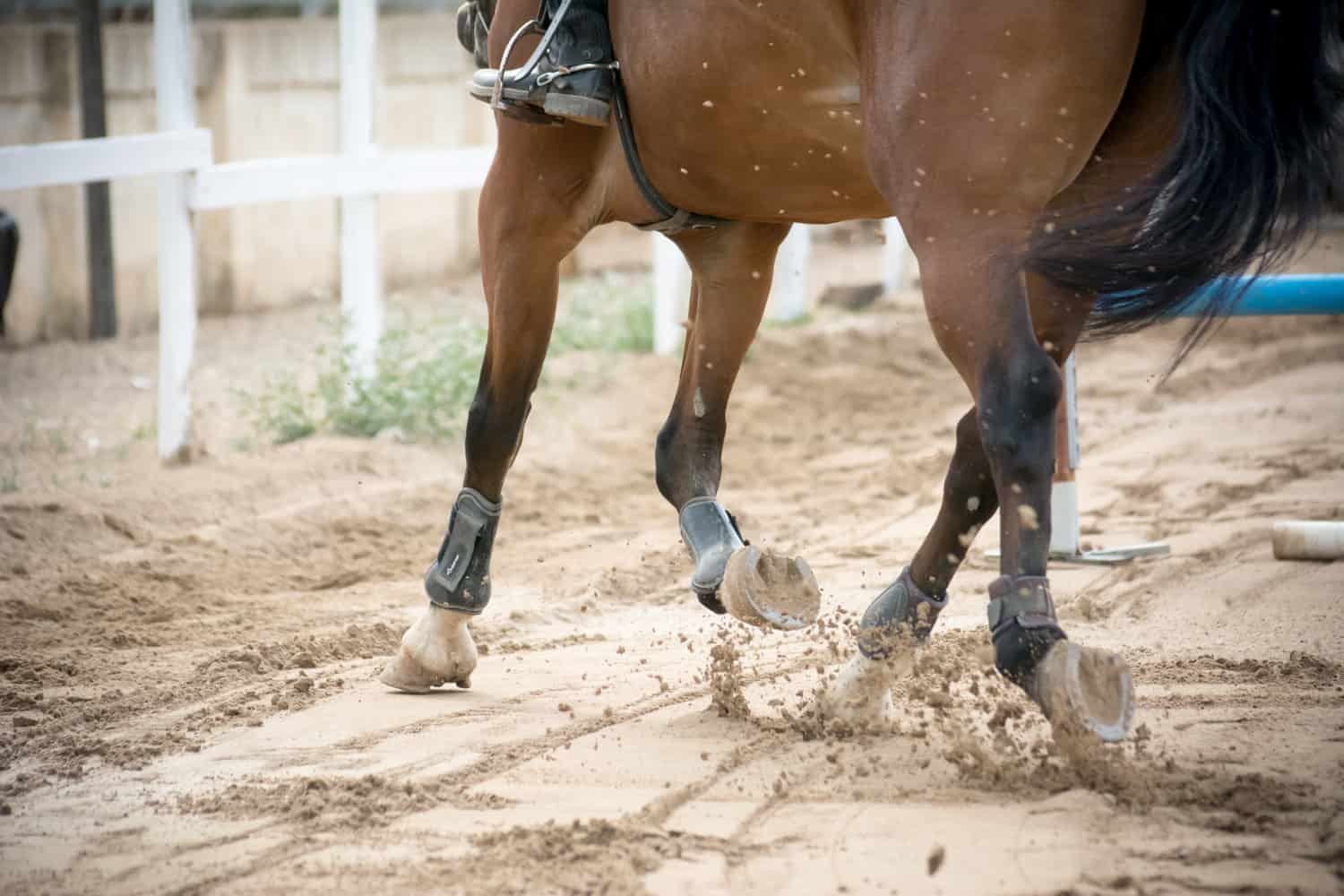Horses need shade as protection from the sun’s harmful rays and to prevent overheating. Providing proper shade not only helps horses stay cool and comfortable but also reduces the risk of sunburn and heat stress. Shade also helps to protect their eyes and sensitive skin from irritants and insects. It is essential to ensure that horses have access to shade throughout the day, especially during the hottest hours.

Creating a Comfortable and Safe Shelter for Horses
When it comes to providing a comfortable and safe environment for horses, a well-designed shelter is essential. Horses are sensitive animals that require protection from the elements and a place where they can rest and feel secure. In this section, we will explore the key elements of creating a shelter that meets the needs of horses.
1. Location
The first step in creating a horse shelter is choosing the right location. It should be situated in a flat, well-drained area that is easily accessible for both horses and caretakers. The shelter should be placed away from noise and distractions, providing horses with a calm and peaceful environment.
2. Size and Design
The size of the shelter will depend on the number of horses it needs to accommodate. A general rule of thumb is to provide at least 100 square feet of space per horse. The design should include a sturdy roof that protects from rain, snow, and harsh sunlight. The shelter should be well-ventilated to ensure proper airflow and prevent the buildup of moisture and odors.
3. Flooring
The flooring of the shelter is crucial for the comfort and safety of the horses. It should be non-slip and provide good drainage to prevent the accumulation of water and mud. Materials like rubber mats or crushed stone can be used to create a durable and easy-to-maintain surface.
4. Fencing
Proper fencing around the shelter is essential to ensure the safety of the horses. It should be strong, secure, and free from sharp edges or protruding nails that could potentially injure the horses. The height of the fencing should be adequate to prevent horses from jumping or leaning over it.
5. Ventilation and Lighting
Good ventilation is crucial to maintaining a healthy environment inside the shelter. Proper air circulation helps to prevent the buildup of dust, ammonia, and mold, which can be harmful to horses’ respiratory health. Natural lighting should also be considered, as it helps create a more comfortable and inviting atmosphere.
6. Bedding and Maintenance
Choosing the right bedding is important for the comfort and health of the horses. Straw, shavings, or specialized horse bedding can be used to provide a soft and clean surface. Regular maintenance of the shelter is necessary to ensure cleanliness and prevent the spread of diseases. Cleaning the shelter regularly, removing manure, and replacing bedding when needed are essential tasks.
7. Safety Measures
Lastly, it is important to consider additional safety measures to further protect the horses. This may include fire prevention measures, such as installing fire extinguishers and ensuring the shelter is built with fire-resistant materials. Providing secure storage for hazardous materials and keeping the shelter free from potential hazards, such as loose wires or toxic plants, is also crucial.
In summary, creating a comfortable and safe shelter for horses involves careful consideration of various factors. By selecting the right location, designing a suitable structure, ensuring proper flooring, fencing, ventilation, and lighting, choosing appropriate bedding, and implementing safety measures, horse owners can provide their animals with a secure and inviting space to thrive.

Providing Adequate Shade in Horse Pastures
When it comes to horse care, providing adequate shade in pastures is of utmost importance. Horses, like humans, can suffer from various heat-related conditions, and a lack of shade can exacerbate these issues. In this section, we will explore the significance of shade for horses and discuss different ways to ensure they have access to a comfortable and shaded environment.
The Importance of Shade for Horses
Horses are highly susceptible to heat stress and can experience heat exhaustion or even heat stroke if exposed to prolonged periods of direct sunlight without any shade. The risks of overheating are particularly high during the hot summer months, but horses can also suffer from heat-related issues in milder temperatures.
Excessive heat can lead to dehydration, fatigue, and a decrease in performance. It can also increase the risk of respiratory problems, such as exercise-induced pulmonary hemorrhage. Additionally, horses with light-colored coats or pink skin are more susceptible to sunburn and skin conditions if not adequately protected from the sun’s harmful UV rays.
Creating Shade in Horse Pastures
1. Natural Shade:
The most natural way to provide shade in horse pastures is by utilizing existing tree cover. Large, mature trees can offer excellent shade and help create a comfortable environment for horses. However, it’s crucial to assess the type of trees in the pasture to ensure they are safe for horses, as some trees can be toxic if ingested.
2. Man-Made Structures:
If natural shade is limited in the pasture, it’s essential to consider constructing man-made structures to provide adequate shade. The most common man-made structures include run-in sheds, shelters, or barns. These structures should be sturdy, well-ventilated, and positioned strategically to offer maximum shade throughout the day.
3. Shade Cloth or Covers:
Another option is to install shade cloths or covers. These can be attached to existing structures, fences, or posts to create additional shade areas. Shade cloths should be made of durable material that can withstand weather conditions and periodically checked for any wear and tear.
Additional Considerations
1. Location:
Ensure that shade structures or natural shade areas are strategically placed in the pasture to provide shade during the hottest parts of the day. Consider the position of the sun throughout the day to determine the optimal location for shade areas.
2. Adequate Space:
Ensure that there is enough shade available for all horses in the pasture. Overcrowding under a limited shade source can lead to discomfort and potential conflicts among the horses. Monitor their behavior and provide additional shade if needed.
3. Maintenance:
Regular maintenance and inspection of shade structures are essential. Trim any overhanging branches to prevent them from falling onto the pasture and potentially injuring the horses. Make sure the structures are secure and free from any sharp edges or hazards.
In Summary
Providing adequate shade in horse pastures is crucial for their overall well-being and health. Whether through natural tree cover, man-made structures, or shade cloths, horses should have access to shaded areas during hot weather to prevent heat-related issues. It’s important to consider the location, space, and maintenance of these shade options to ensure they are effective and safe for the horses.

The Effects of Heat and Sun on Horses
As equestrians, it is important to understand the effects of heat and sun on horses. Horses are highly sensitive animals and extreme weather conditions can have a significant impact on their health and well-being. In this section, we will explore the various effects of heat and sun on horses and discuss ways to mitigate these effects.
1. Dehydration
One of the most common effects of heat and sun on horses is dehydration. Horses can lose a significant amount of water through sweating, especially during hot summer months. Dehydration can lead to a number of health issues, including decreased performance, lethargy, and in severe cases, heat stroke. It is crucial to ensure that horses have access to clean and fresh water at all times, especially during hot weather.
2. Heat Stress
Horses are more prone to heat stress compared to humans due to their large size and inability to sweat as efficiently. When a horse is exposed to prolonged periods of high temperature, it can lead to heat stress. Common signs of heat stress in horses include excessive sweating, rapid breathing, elevated heart rate, and fatigue. It is important to provide horses with adequate shade and ventilation to help them cool down and prevent heat stress.
3. Sunburn
Horses with light-colored or unpigmented skin are particularly susceptible to sunburn. Areas such as the muzzle, ears, and pink skin around the eyes are more prone to sunburn. Sunburn can be painful for horses and can lead to skin damage and discomfort. To protect horses from sunburn, it is recommended to apply sunscreen or cover sensitive areas with fly masks or lightweight sheets during periods of intense sun exposure.
4. Hoof Issues
Extreme heat can also affect the hooves of horses. Prolonged exposure to hot surfaces, such as asphalt or sand, can cause the hooves to dry out and become brittle. This can lead to cracks and other hoof issues. Regular hoof care, including moisturizing and proper trimming, can help prevent heat-related hoof problems.
5. Decreased Performance
Heat and sun can also have a negative impact on the performance of horses. Just like humans, horses can experience decreased stamina and endurance in hot weather. High temperatures can make it difficult for horses to regulate their body temperature, leading to fatigue and reduced performance. It is essential to adjust training and exercise routines during hot weather to prevent overexertion and ensure the well-being of the horses.
6. Electrolyte Imbalance
In hot weather, horses lose not only water but also essential electrolytes through sweating. Electrolytes play a crucial role in maintaining proper muscle function and overall health. An imbalance of electrolytes can result in muscle cramps, fatigue, and even colic. Supplementing horses with electrolytes can help restore the balance and support their overall well-being during periods of heat and sun exposure.
In summary, heat and sun can have significant effects on horses. It is important for equestrians to be aware of these effects and take necessary measures to protect their horses from dehydration, heat stress, sunburn, hoof issues, decreased performance, and electrolyte imbalances. Providing access to shade, fresh water, proper hoof care, and adjusting training routines during hot weather are key to ensuring the well-being and health of our equine companions.
Tips for Ensuring Horses Stay Cool in Hot Weather
As temperatures rise during the summer months, it is important for horse owners and caretakers to take steps to ensure that their equine companions stay cool and comfortable. Horses are highly susceptible to heat stress and can quickly become overheated, leading to serious health issues. To help you keep your horses safe and cool during hot weather, we have compiled a list of essential tips.
1. Provide Ample Shade
Horses should have access to shade at all times, especially during the hottest parts of the day. Whether it’s natural shade from trees or man-made shelters, make sure your horses have a cool place to escape the sun’s rays. This will help prevent them from overheating and reduce the risk of sunburn.
2. Use Fans and Misters
Installing fans and misters in your horse’s shelter or stable can significantly decrease the ambient temperature. Fans help circulate the air, creating a cooling breeze, while misters release a fine mist of water that evaporates and cools the surrounding area. These cooling devices can make a big difference in keeping your horses comfortable.
3. Provide Fresh, Cool Water
It is crucial to ensure that your horses have access to fresh, cool water at all times. In hot weather, horses tend to drink more to stay hydrated. Check their water supply regularly to make sure it is clean, free of debris, and cool. You can also add electrolytes to their water to help replenish essential minerals lost through sweating.
4. Schedule Turnout and Exercise Wisely
During extremely hot weather, it is best to limit exercise to the cooler parts of the day, such as early morning or late evening. Avoid riding or working your horse during the hottest hours, as this can put them at risk of overheating and exhaustion. Additionally, be mindful of the intensity and duration of exercise to prevent excessive heat build-up.
5. Provide Adequate Ventilation
Proper ventilation is essential for maintaining a comfortable environment for horses. Ensure that their stables or shelters have good airflow to prevent the accumulation of heat and humidity. You can install vents or open windows to allow for natural air circulation, which will help keep your horses cool.
6. Use Lightweight and Breathable Fly Sheets
Fly sheets can provide protection from both flies and the sun’s rays, but it’s important to choose lightweight and breathable materials. Look for sheets that offer UV protection and have mesh panels to allow for airflow. Avoid heavy or non-breathable fabrics that can trap heat and cause discomfort.
7. Monitor for Signs of Heat Stress
Keep a close eye on your horses for any signs of heat stress or heat stroke. Symptoms may include excessive sweating, rapid breathing, lethargy, elevated heart rate, and elevated body temperature. If you notice any of these signs, take immediate action to cool your horse down by applying cool water, providing shade, and contacting a veterinarian if necessary.
8. Adjust Feeding Schedule
During hot weather, consider adjusting your horse’s feeding schedule to avoid peak heat times. Feeding smaller meals more frequently will help prevent digestive issues and reduce the metabolic heat produced during digestion. Additionally, provide access to salt blocks or electrolyte supplements to encourage water intake and maintain electrolyte balance.
9. Limit Grazing Time
Horses need access to fresh pasture, but during hot weather, it is best to limit grazing time to early mornings or late evenings when temperatures are cooler. This will prevent them from overexerting themselves in the heat and reduce the risk of dehydration.
10. Be Prepared for Emergencies
Lastly, always be prepared for emergencies. Have a well-stocked equine first aid kit on hand that includes items such as ice packs, thermometer, electrolytes, and contact information for your veterinarian. Familiarize yourself with the signs of heat-related illnesses and know what steps to take in case of an emergency.
By following these tips, you can help ensure that your horses stay cool and comfortable in hot weather. Remember, their well-being is in your hands, so it is essential to prioritize their safety and take proactive measures to prevent heat stress. With proper care and attention, you can keep your equine friends happy and healthy all summer long.
FAQs
Do horses need shade?
Yes, horses need shade to protect themselves from the sun’s harmful rays and to stay cool during hot weather. Providing access to shade helps prevent heat stress and sunburn in horses.
Conclusion
In conclusion, providing shade for horses is essential for their overall well-being and health. Horses are sensitive to extreme weather conditions, especially heat and direct sunlight. The provision of shade not only helps in regulating their body temperature but also protects them from the harmful effects of ultraviolet (UV) rays and potential heat stress. Shade also offers respite from insects and flies, ensuring a more comfortable environment for horses. It is crucial to have ample shade options available in pastures, paddocks, and turnout areas to allow horses to seek shelter whenever needed. Ultimately, proper shade management contributes significantly to the overall welfare and happiness of horses.
